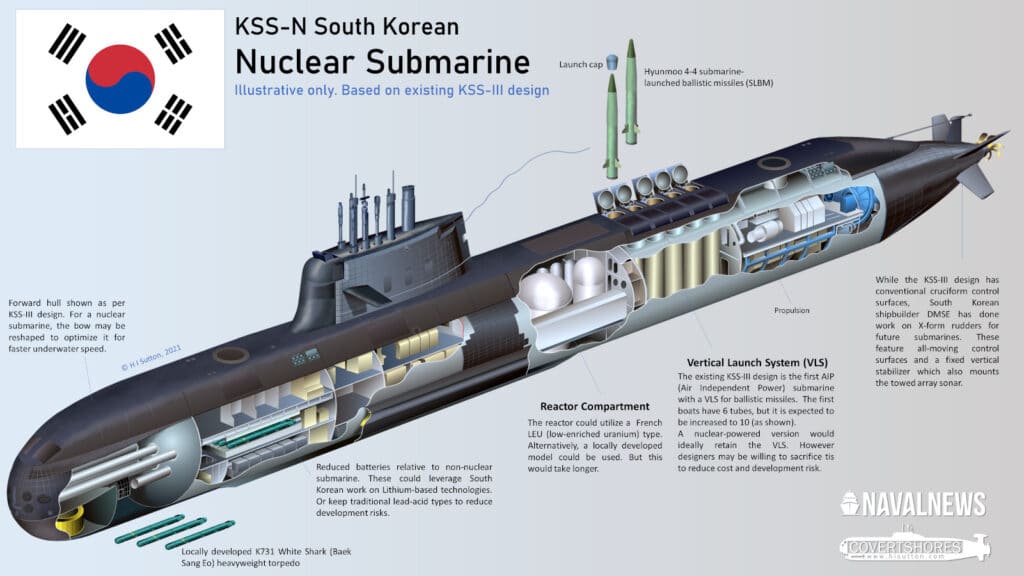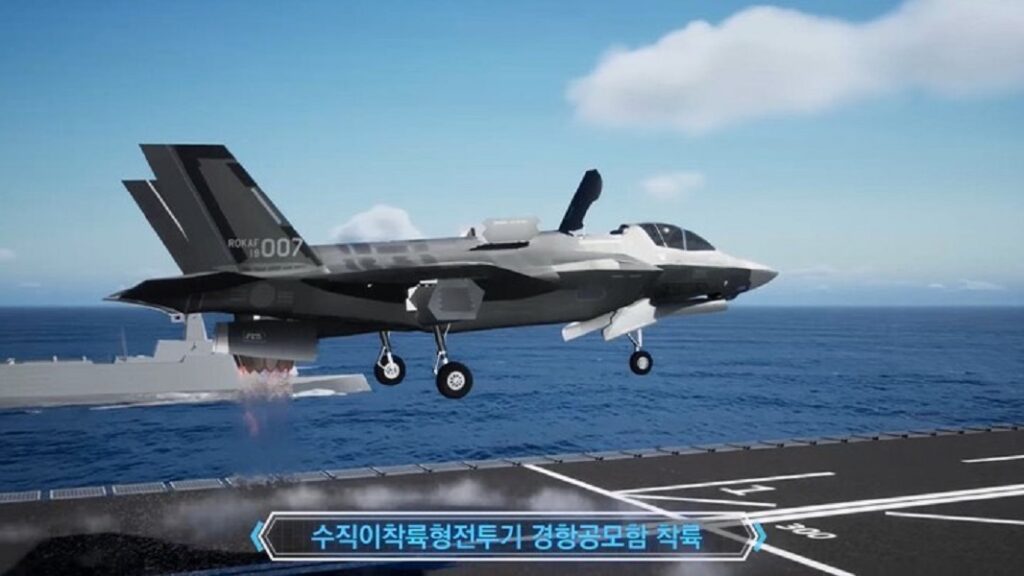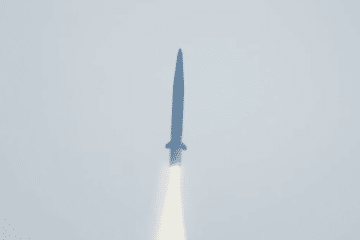Facing these potential security threats that originate from their military rise, the Korean Ministry of National Defense (MND) and the Blue House led by the outgoing president Jae-in Moon officially released the mid-term plan of national defense last August to announce that Seoul will acquire a light aircraft carrier of 30000 tons by 2033 as a part of its CVX project, planning to spend 2.6 trillion Korean won for the construction with two largest shipbuilders, Hyundai Heavy Industries (HHI) and Daewoo Shipbuilding and Maritime Engineering (DSME), respectively allying with western companies such as Babcock International and Fincantieri and competing against each other to win the governmental contract.
So far, pro-CVX experts emphasize the need for Korean aircraft carriers due to the growing importance of maritime security near the surrounding waters of South Korea, areas of conflict including the South China Sea, and Japan’s territorial claim over Dokdo, the side anti-CVX argues the absurdity of the aircraft carrier given the neighboring states’ naval power, consuming costs and time of developing it.
CVX in the crosshair

Most importantly, the prospect for the ambitious CVX of the Republic of Korea Navy (ROKN) has become dimmer and dimmer now. As the presidential election on March 9th, this year elected the conservative candidate Suk-yeol Yoon of the People Power Party (PPP) as the new president after the liberal Moon administration, the CVX project that has faced harsh criticism seems to become closer to the end.
The project has gone through ups and downs over time, particularly during the budget deliberation of the National Assembly where the then-ruling liberal Democratic Party (DP) and the conservative People Power Party clashed. The finalized plan should enable the project to be proceeded by starting a basic design, but the recent regime change from Moon to Yoon is certainly projected to bring overall changes in the new administration’s defense policy, growing more skepticism on further continuation of CVX as the People Power Party that has maintained negative stance on acquiring the light aircraft carrier took the presidency as the new ruling party.
When Cheol-soo Ahn, the current chairman of the Yoon’s presidential transition team, agreed to the single candidacy with Yoon during the presidential race, Ahn said, “There would be synergy to create a better solution for South Korea if we could discuss what is more necessary between a light aircraft carrier and a highly functional fighter jet.” This gives more weight to the acquisition of fighter jets such as F-35 and KF-21, rather than an aircraft carrier.
Yoon’s nominee for his first Defense Minister and the former Vice Chairman of the Joint Chiefs of Staff (JCS), the retired Lieutenant General Jong-sup Lee also showed his prudence by answering, “I’m aware that there are different opinions on the ROKN’s ambition for the CVX project.”, when asked about his view on the CVX project. The nominee Lee also mentioned key standards in considering the improvement of military power: strategic and operational concept, meeting military requirements, contribution to national interests, and cost-efficiency.

The Korean Navy received KIDA (Korea Institute for Defense Analyses)’s conditional and MND’s full green lights to proceed with the project, but it confronted strong opposition at the National Assembly last year while finalizing the 2022 budget, and then the CVX budget was considerably cut from the original 7.2 billion Korean won to 500 million Korean won. As liberal and conservative parties failed to elicit a bipartisan agreement in the plenary session, the Democratic Party railroaded the budgetary plan that included the complete CVX budget of 7.2 billion Korean won, which was interpreted by local reports that the result totally reflected the thought of the Blue House and the president Moon.
However, the project once considered the ‘VIP agenda’ by the liberal party is unlikely to gain momentum in the Yoon administration. A well-informed source in the Korean military told, “As the ruling party unilaterally pushed the budget plan last year, the new government and the People Power Party could say they will not succeed in the CVX project initiated by the previous Moon government.”
New Administration, New Priorities in Defense

Another factor that frustrates CVX acquisition is that Yoon is likely to start first focusing on reorganizing the military since Yoon might have learned from the abject failure that Russian forces have faced in Ukraine: Russia has been defeated as the country has always been way too concentrated on showing off its nuclear arsenal and how it is seen externally, not caring about strengthening combat capabilities of deployed forces. The war in Ukraine proved that a military that is capable of carrying out combat duties is more effective than a gigantic army that possesses technically new and advanced weapons.
Applied this lesson to the ROK Navy, Yoon may prefer exerting current military capabilities to the maximum than acquiring eye-catchy assets such as a light aircraft carrier, by reinforcing the number of ship crews, a stockpile of ammunition, and precision-guided weapons, enabling maintenance of more often, and rescheduling the anchoring period of ships, etc.
As a matter of fact, both DP and PPP raised problems that the ROK Navy internally has had: the increasing number of leaving submarine crews since 2020, malfunction of target designators of KDX destroyers’ surface-to-air missiles, too long time of preheating target designators, expensive costs and lack of key components of the designators, etc. Also, the DAPA (Defense Acquisition Program Administration) might also be shrunk in terms of its size, and its responsibilities could be transferred to each military branch or the MND. Such assurances of the Korean military’s combat readiness and strengthened training would also daunt the acquisition of new weapons on a large scale.
“North Korea will not sit and just see Seoul’s acquisition of new assets. The North is highly likely to continue ground- and sea-based provocations in order to prevent such military growth. It is highly possible that even a simple tantrum of the North possibly make Seoul focus again on security issues of the Korean Peninsula and prioritize developing an indigenous missile defense system.”
Dr. Robert Kelly, a political scientist and North Korean expert at Pusan National University
Even though a top official of the outgoing Moon administration oppositely answered to the press that “We will make sure that public hearing and discussion sessions with an expert would be held to help the audience understand and communicate better.”, the incumbent Chief of Naval Operations (CNO) appointed by Moon last December, Admiral Jeong-soo Kim, who clarified that the ROK Navy will continue the CVX project without pause, will be replaced with another admiral by the incoming president. This increases the uncertainty of the current CVX and it is not likely to remain on the table of the new administration. All things considered, the new mid-term 2023-2027 national defense plan which will be announced by the MND later will be a watershed on whether big but controversial projects like CVX would be succeeded by the new government or not.
Nuclear-powered Submarine: K-SSN on the verge?

The nuclear-powered submarine, called SSN or SSBN (when SLBMs are loaded), is considered a ‘weapon of dream’ that all Navies around the world would be interested to possess, because as a strategic asset, it could target enemies anytime and anywhere with either SLBM (submarine-launched ballistic missile) or conventional weapons, based on its nuclear fuel that enables theoretically unlimited period of underwater operations at sea. Only seven countries in the world possess either SSN or SSBN: the United States, Russia, United Kingdom, France, China, and India. The North has recently sought to be the seventh in the world by the mid-2020s according to Kim Jong Un’s address early this year.
Not included in the list of seven, Seoul has continuously considered the introduction of K-SSN since the late president Moo-hyun Roh in the early 2000s, but has not been fruitful yet. Even the president Jae-in Moon asserted a presidential pledge to acquire SSNs, but the Blue House was gridlocked by political concerns of Washington, ROK-U.S. Agreement for Peaceful Nuclear Cooperation, and lack of routes to acquire nuclear fuel. According to the required capabilities of Chang Bogo-3 (KSS-III) Batch-3, South Korea aims to develop the batch as SSN of 4000 tons.
It is also reportedly said that the Batch-3 will be more than 5000 tons in full displacement and carry 10 SLBMs based on the series of indigenous Hyunmoo ballistic missiles, but the MND avoided commenting on a specific propulsion system by observing that it is not appropriate to mention it at this stage.
Winning the Heart of the Domestic Public and Politics via CVX and KSS-N projects

As CVX widely drew neighboring countries’ and Korean public’s attention, K-SSN also already ignited the public opinion with two divided sides: the improvement of cost-effective anti-submarine warfare capabilities against the North and the necessity of SSN as a strong deterrent that is capable of strategic strikes. Strictly speaking, the Korean public opinion already shows non-partisan support for K-SSN.
According to the most recent poll conducted by KRi (Korea Research Institution) and the KINU (Korea Institute for National Unification) from October to November last year, 75.2 percent out of 1006 surveyed Korean nationals favored SSN. 78.3 percent of pro-Democratic Party voters and 72.9 percent of pro-People Power Party voters commonly agreed in the poll.
Even the presidential election could not dodge the SSN issue. The then-ruling party DP first claimed the nuclear-powered submarine is essential. The DP candidate Jae-myung Lee pledged to acquire SSN based on the ROK-U.S. alliance and bilateral diplomatic cooperation to persuade Washington and modify the nuclear agreement.
In contrast, the PPP president-elect Yoon seems to prioritize strengthening ISR (intelligence, surveillance, and reconnaissance) based on the trilateral security cooperation with Washington and Tokyo, and such capabilities are expected to be reinforced first unless China or North Korea catalyze and convince him to acquire SSN for Seoul’s defense. Since Yoon’s presidential candidacy, he often mentioned THAAD (Terminal High Altitude Aerial Defense) as an example to improve defensive capabilities instead of SSN or CVX.
However, as the North’s strong will to test SLBMs and develop nuclear powered ballistic missile submarines known as SSBNs is stronger than ever, and China will accelerate its maritime rise in the region as a counter-response to the U.S. Navy, it could be difficult for the Yoon administration to resist the temptation to consider SSN seriously. In other words, ignoring the public and political circles’ favor for the possession of nuclear-powered submarines, supported by more than 70 percent of South Koreans, will not be easy at all.
The Defense Minister nominee Jong-sup Lee who practically opposed to CVX showed a positive stance toward SSN and said, “Nuclear-powered submarines are known to have operational efficiency as they are faster and able to submerge for a longer time than conventional diesel submarines. We need to take into consideration the defense budget, our technical level, and changes of the surrounding security environment.” Lee picked close coordination and bilateral bond of consensus as key factors to solve the issue of acquiring nuclear fuel.
Given these aspects, the new administration is not likely to completely abandon the SSN option, and the ADD (Agency for Defense Development) and research institutes are expected to continue their relevant R&D.
Checks from Allies and Balances of Power Through Asymmetry

Not only the Korean Naval Academy professor Ji-hoon Yu and the New York State University professor Eric French wrote to The Diplomat to urge the US support for K-SSN, but the French ambassador to South Korea Philippe Lefort also conveyed willingness last September to further discuss with the Korean government on cooperating or striking a deal on nuclear waste reprocessing, emphasizing that France holds all relevant military technologies for aircraft carriers and nuclear-powered submarines.
Jagannath P. Panda, Coordinator of the East Asia Centre of the Indian think-tank Institute for Defence Studies and Analyses observed that Seoul might choose to cooperate with Paris to develop SSN if the United States excludes South Korea from AUKUS and refuses to transfer or support SSN technology. The 2nd Director of the National Security Office, Hyun-jong Kim visited Washington in October 2020 to request the nuclear fuel supply for K-SSN, but the White House declined the reason of the non-proliferation principle while deciding to transfer nuclear-powered submarines to Australia exceptionally.
The professor at the Korea National Defense University, Young-jun Park contended that South Korea needs to concentrate on acquiring deterrence capabilities including SSN as the North keeps advancing its nuclear arsenal, on the condition that several other trust-earning measures should be taken at a governmental level and gaining trust from the United States is most essential because the military use of nuclear energy is still prohibited by the mutual nuclear agreement.
The claim from the public that SSN is necessary for both deterring the nuclear-armed North and keeping up with the pace of the Asia-Pacific naval race is gaining more persuasiveness. China and Japan are reported to have better navies in terms of size and quality compared to that South Korea, which makes it much harder to overcome the power gap. The Northeast Asian arms race running in parallel requires an asymmetric asset to offset the different power indexes.
The security situation of the Korean Peninsula and the domestic public opinion give more weight to building SSN, but massive costs and consumption time remain obstacles. Australian Strategic Policy Institute (ASPI) estimated in its research that the country will need 171 billion Australian dollars to build eight SSNs. SSN is more convincing than CVX so far from the view of the public, but the public could cast doubt in efficiency and viability if the money-draining SSN project does not fill in the technical gap after investing an astronomical budget to reach the certain technical level that the seven nuclear-armed states already have now.
Another issue to handle is the nuclear fuel that SSNs need for propulsion. Some point out that Seoul needs to import technical understanding and knowledge from countries that have experience in building nuclear-powered submarines. As the current nuclear agreement between South Korea and the United States limits Korea’s uranium enrichment to less than 20 percent and its use for military purposes, Yoon would need to discuss the issue during the bilateral Strategic Consultative Meeting (SCM) every October or the Yoon-Biden summit talk for the sake of future deterrence and national defense facing northern threats in a bigger picture.
Looking Ahead in A Bigger Picture

The new president Yoon, being well aware of the significance of the ROK-U.S. relations, declared to maintain the staunch alliance with Washington by eventually joining the Quad in the end. Since the Biden administration has also recognized this and has higher expectations now to strengthen the alliance and closer cooperation, only Yoon’s will could reignite discussions on K-SSN and the modification of the nuclear agreement. It is totally up to the new administration’s diplomacy to persuade the U.S. about what and how K-SSN could contribute to the stability of the Asia-Pacific region and allies.
The Moon administration has not been actively synchronized well as much as the Quad states and European allies did with Washington, Biden has made a precedent by lifting the ROK-U.S. missile guidelines in May 2021 that blocked Seoul’s missile development more than 40 years since the 1970s, solely for the purpose of deterring growing China and North Korea. Depending on how surrounding security variables in Northeast Asia span out for the next five years of Yoon’s presidency, the White House’s strongly hawkish stance on making even slight changes in the nuclear agreement could possibly change in the mid-term, presumably by the late 2020s.
The recent proactively positive change in Washington’s attitude towards the Australian SSN proves that the United States tends to make moves when realistic national interests correspond to its goal of facing the maritime rise of the Chinese Navy.
Although France backlashed against the advent of AUKUS that motivated Australia to scrap the French diesel submarine sales deal, there are chances for cooperation in a broader framework of systematically linked multilateral security cooperative systems of the NATO (North Atlantic Treaty Organization), the Quad (the Quadrilateral Dialogue) Plus, and AUKUS Plus joined by South Korea, Japan, India, and Europe. Kurt Campbell, the Indo-Pacific Coordinator of the National Security Council of the White House referred AUKUS as “open architecture”, leaving open the possibility that other countries in Asia and Europe would participate in some way in the future.
As covered before, the ROK Navy successfully test-fired SLBMs underwater several times since last October, recently accomplishing a real-time simultaneous launch with two salvos of SLBMs at the interval of 20 seconds in an operation at sea. South Korea has become the world’s first country that loaded indigenous SLBMs the conventional diesel submarines by combining SSN’s strategic strike capability. Accordingly, along with the unexpectedly easygoing acquisition of Hyunmoo-variant SLBM, the public and military-strategic demands for SSN could increase as time goes under the threats posed by Pyongyang and Beijing.






